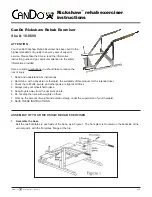
12
4.
Pull the locking catch on the backrest lever, then
pull the main lever (Fig 24, Item 1). Move the
backrest to the desired measurement. The
backrest angle measurement can be read off the
scale at the top of the backrest adjustment slide
(Fig 25, Item 3).
5.
Release the backrest adjustment lever to secure
the backrest at the desired angle.
6.
If locking out the backrest is required, return the
locking lever to the locked position. If the locking
lever is too loose or too tight it may be necessary
to rotate the whole lever clockwise or anti-
clockwise respectively to achieve the desired
locking action.
7.
If locking out the backrest is not required there is a
Velcro strap that can be used to hold the lever in
the unlocked position
–
see Fig 26.
Tilt-in-Space Angle Adjustment
1.
Make sure the brakes on all 3 locking castors are
locked on.
2.
Pull and hold the tilt-in-space lever (Fig 24, Item 2)
and move the chair to the desired tilt-in-space
angle
3.
Release the lever to lock the tilt-in-space angle.
Manual Forward Tilt Adjustment
This function enables some patients to exit the chair
more easily, however it must only be used following a
risk assessment of the patient.
1.
The chair is delivered with this function locked.
Remove the lock bolts on both LHS and RHS side
on the chair using an Allen key. Ensure the correct
bolts (item 1 in Figure 27) are removed.
2.
Retain the lock bolts in case they need refitting in
the future.
3.
Remove the footplate (See section 9).
4.
Make sure the brakes on all 3 locking castors are
locked on.
5.
Ensure it is safe to move the chair into the forward
tilt position.
6.
Pull and hold the tilt-in-space lever (Fig 24, Item 2)
and move the chair forward to the forward tilt
position.
Leg rest Adjustment
1.
Make sure the brakes on all 3 locking castors are
locked on.
2.
Locate the leg rest adjustment lever (Fig 24, Item
3).
3.
Pull and hold the lever, then move the leg rest to
the desired position.
4.
Release the handle to secure the leg rest in
position.
1
Figure 25
2
3
Figure 26
WARNING
Footplate must be removed before using the
manual forward tilt function.
1
Figure 27










































